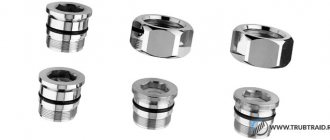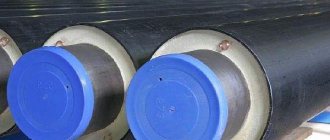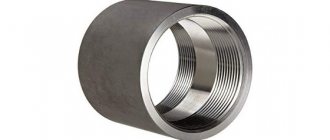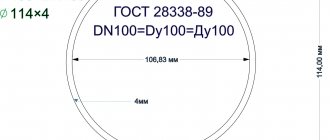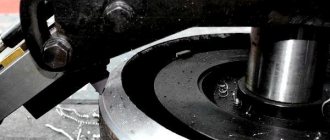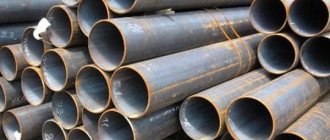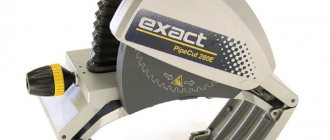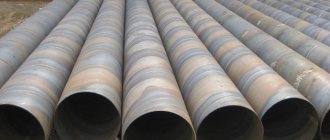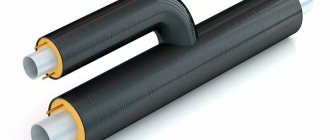Menu:
- Steel pipes: types of joints
- About threaded joining of steel risers
- Connection methods
- How and what to seal pipe joints with
- Types of seals, sealing methods
- Materials for sealing joints
- Threaded pipe connections: pros and cons
- General thread requirements
- Malleable cast iron and connecting parts made from it
- Video
All pipelines are installed according to the pipeline system designs. When laying metal pipes for heating, gas and water supply (cold and hot water), it is necessary to connect the fittings and risers.
The quality of functioning of the gas pipeline, water supply system, and heating system, which is designed to use steam under pressure or hot water with temperatures up to 95 - 100⁰C, depends on the reliability of the articulation of the elements of the pipeline.
The optimal temperature range according to GOST heating systems is up to +60⁰С, depending on operational, climatic and other factors.
Steel pipes: types of joints
Steel pipe connections can be permanent or collapsible, depending on:
- materials from which the risers are made. In addition to metal pipes, cast iron, glass, polymer, and copper products are used;
- properties of transported media;
- operating conditions.
Most often used:
- coupling (threaded, welded, bayonet, sleeve);
- flanged;
- threaded
Disconnect joints. Let's focus on the last option.
Design features of couplings - components
Flange products consist of a pipe and a metal flange. Compression ones - made of a body, a clamping and sealing ring, as well as a press-fit bushing and a cover-nut. The clamping ring protects the structure from sudden loosening, which can be caused by shocks and water hammer. But the sealing element ensures tightness at the joints. This, in turn, is secured by a bushing. The cover nut also plays an important role, because it is what holds the entire mechanism.
Flange couplings
Electric welded couplings consist of a housing, a heating element and terminals. The spiral is made of a special material. It can be hidden or open. But the latter option is used very rarely, since this arrangement is unsafe. Basically, manufacturers prefer a semi-open spiral. Thus, it is possible to ensure a good level of safety and uniform heating of the material.
About threaded joining of steel risers
The threaded connection method is typical for working with steel pipes. To apply threads, use a lathe or die. Cylindrical rolling threads are applied to thin-walled risers.
If the installation rules are followed when laying steel pipes, then twisting in this way will ensure high-quality functioning of the pipeline for many years.
Screwing using threads can be carried out either by directly connecting pipes to each other, or using tees, couplings, shut-off valves, and additional devices.
How to connect without threading and welding
Next you will learn how to connect metal pipes without welding or threading. Speaking about connecting metal pipes, this method cannot be ignored, because it is very popular during installation work.
We will talk about flange connections. To perform this, they take special fittings, which are called flanges. These parts are equipped with a rubber gasket. The joint itself is performed in the following sequence:
- A cut is made in the fastening area. It is performed clearly perpendicularly, and there should be no burrs. The end chamfer is not needed here.
- A flange is placed on the prepared cut.
- After this, a rubber gasket is inserted, which should extend 10 cm beyond the edges of the cut.
- A flange is placed on the gasket. After this, it is fastened to the mating part of the flange on the second metal pipe.
- Do not overtighten the bolts while tightening the flanges.
The next connection option is a coupling connection. This method makes it possible to produce a reliable, highly airtight joint.
Installation work is carried out in the following sequence:
- Metal pipes prepared for fastening are cut off at the end parts. The cut on them should be made perpendicularly and ensure that it runs smoothly.
- A coupling is applied to the connection area. The center of the connecting element must be located exactly along the pipe joining area.
- Markings are made on the pipes with a marker; it will indicate the position of the fitting.
- The end parts of the connection are coated with silicone grease.
- One pipe is inserted into the connecting part according to the mark. After which, the second one is placed in the same center line with the first one, and only after that it is attached to the coupling. The marker placed with a marker will serve as a guide when dressing.
Watch the video
Connection methods
Threaded and non-threaded connections can be of a collapsible or non-separable type. Many are confident that any structure with threads can be disassembled.
If one end of the risers is welded to a fixed surface, then such a pipe device cannot be disconnected. This option is a typical example of a permanent threaded connection.
But such cases are rare. The main number of twists using threads is of the detachable type.
The risers are connected to each other using:
- sweeps;
- bidirectional thread.
Squeegees are used to twist pipes that are motionless relative to their own axes.
Required condition
: one riser must have a long thread cut, and the second a short one.
To connect in this way, first screw the locknut with the coupling onto the long thread. After this, you need to drive the coupling onto a section of the pipe with a short thread, and then tighten it with a lock nut.
The technique of using bidirectional threads is that only a coupling is used to join pipes. It must be screwed onto both risers simultaneously.
Important! When using bidirectional threads, the pipes being connected must be threaded in different directions. Only in this case will the coupling tighten the pipes, and the twisting will be high-quality, reliable, and durable.
How to connect metal pipes - step-by-step diagram
Step 1: Preparatory work
It doesn’t matter what diameter the pipes will be joined, and what type of fitting was chosen - threaded or not, or maybe electric welded, in any case, the surface of the products should be properly prepared. The outer side of the pipes is thoroughly cleaned of dirt and dust. In some cases, it is even necessary to remove a thin top layer from the surface. For this you will need a scraper.
Step 2: Flange connection
This type of fitting is relevant if you have to work with large diameter pipes. One part of the product is mounted on the pipe, and then the second is installed. Fixation occurs through a clamping ring with a rubber seal. If the pipe is threaded, then such a connection is, accordingly, called threaded.
Step 3: Installation of compression elements
We unscrew the fitting so that it freely clasps the hollow element. Then we do a fitting and put marks on the pipe, then during installation we will know the correct location of the parts and, if necessary, adjust it. To facilitate the joining process, it is necessary to apply lubricant to the surface of the pipe. If you don’t have one, it’s okay; plain soap will do just fine. Next, we make the connection and tighten the union nut. The last operation ensures reliable fixation of the fitting even without welding.
How and what to seal pipe joints with
Types of seals, sealing methods
To prevent leakage of the pipeline working fluid, it is necessary to properly seal the pipe twists.
When threading steel pipes, the following are used as seals:
- gasket This method of sealing a threaded connection requires relatively thick end pipe cuts. The presence of smooth pipe ends can never ensure tightness. When using a rubber or plastic gasket, this problem is successfully solved. This option is ideal in case of articulation using a union nut;
- winding The materials can be linen strands, polymer threads, FUM tapes in combination with hardening sealants, paints, pastes.
When installing plastic risers, a sealing method is used based on the deformation properties of the material. The essence of this method is that a plastic pipe with an external thread is screwed into a riser with an internal thread. During deformation, plastic contributes to excellent filling of the intermediate space, eliminating the appearance of gaps.
When it comes to pipeline structures with high pressure, cylindrical threaded pipe connections are not entirely appropriate here. In such cases, a conical type connection is used. The principle of connection is that when screwing in, the pipes are tightly pressed until the gap completely disappears.
Materials for sealing joints
To make the joint impenetrable, the following are used as seals:
- flax (tow);
- asbestos;
- FUM tape;
- natural drying oil;
- whitewash;
- minium;
- graphite lubricant, etc.
A reliable sealant when twisting steel pipes onto threads is strands of flax impregnated with red lead or white lead. This connection is easy to install and reliable in terms of sealing. The seal has been used for a very long time and does not lose its popularity today, despite the emergence of artificial analogues.
For those who have little experience in installing fittings and pipes, we suggest that under no circumstances use flax without paint.
At first, the joint will not allow moisture to pass through. But several months will pass, the flax fibers will get wet and begin to decompose. Therefore, the quality of all connections will deteriorate, and in another month or two, water will leak at the junction.
Important! The fibers must be thoroughly impregnated with red lead or whitewash so that not a single dry strand remains.
When operating pipelines with a working environment temperature higher than the boiling point of water, the best sealant option is asbestos thread together with flax strands. To do this, they are impregnated with a mixture of graphite and natural drying oil.
Important! You need to coat the joint with the strands first with red lead, and then with whitewash, and not vice versa.
Before use, the strands are combed out so that the fibers can be separated well.
Important! The strands must be wound “behind the thread” and then soaked with paint. If you lay the tow against the cutting direction, then when screwing on the coupling it will all come out to the sides and you will have to start all over again.
Important! To avoid clogging of the risers, you need to ensure that the tow does not hang from the end or get inside the riser.
Many people use FUM tape, which is in no way inferior to old traditional materials - tow with paint.
Sometimes there is no tightness at the junction of the risers. To eliminate this defect, you need to replace the sealing material, and clean the threaded area from dirt and sealant residues. After this, rewind the linen thread, FUM tape or other sealant, and assemble the structure.
Pastes and sealants of chemical origin are used as additional sealants, which will help strengthen this section of the pipeline.
Mounting options
According to their design, all types of pipe connections can be divided into 2 large groups - detachable and permanent. The former allow you to optimize installation, repair operations and maintenance practices for the entire pipeline and joint block: detachable joints can be dismantled, replaced, or restored without damaging the pipeline sections. The most popular solutions:
- threaded;
- using a flange.
The permanent type of pipe connection is a welded structure. It allows you to achieve maximum tightness of the joint, but does not leave the possibility of intervention in the joint area without damaging the material. In addition to the welded method, non-separable methods include socket installation, cementing, gluing and pressing.
Both detachable and permanent types of pipe connections can be economically/technically justified and are used in pipelines for various purposes:
- gas pipelines;
- water pipes;
- heat supply networks;
- sewer systems;
- technical pipelines;
- industrial highways, etc.
Threaded pipe connections: pros and cons
The option using threads has its advantages and disadvantages.
On the positive side, threaded connections differ:
- versatility, which consists in the fact that they can be used for twisting risers of various diameters;
- ease of installation, since to carry out the articulation procedure you do not need to be a professional or have any special knowledge. It is enough to have basic skills in handling a wrench or pipe wrench, or other simple skills in this industry;
- lack of sets of special tools or devices;
- resistance to loads, reliability in operation;
- ease of dismantling the entire pipe structure (if necessary);
- tightness, which is ensured by the presence of sealing materials and compliance with basic rules for laying pipelines.
Flaws:
- if there is no thread on the parts, it is necessary to apply it, which can cause additional difficulties, since not everyone has the skills to cut it and not everyone has sets of special tools;
- when the joints have to be frequently mounted and dismantled, rapid wear of the threaded section of the line part is possible;
- There are times when it is necessary to lock the threaded part, since the fitting may gradually unscrew itself.
Taking into account all the pros and cons, in some situations the best option is to use a threaded connection of steel pipes, and in others, other types of joints of pipeline structure elements. This means that there is no ideal way to connect steel risers: all methods are good if they ensure reliability and tightness of the pipeline.
Important! When choosing a method for joining pipe structures, take into account what material the pipes are made of, the location of the possible connection of parts, operating conditions of the pipeline, and what properties the joining of elements of the pipeline system should have.
Important! For galvanized pipes, only a threaded connection is suitable, since during welding work the galvanization will be damaged, after which the riser will be easily exposed to corrosion.
Types of couplings
Today, there are several types of these connecting elements, each of which has unique qualities. In addition, there are universal options that can be used in almost any case.
The most common type of coupling is a part in the form of a hollow cylinder with different types of fastening
Main types of couplings:
- Threaded - previously such parts were the most popular type and were used everywhere. Now they are used much less frequently, mainly for steel pipes. They are characterized by rather complex installation. This type of connection is not reliable enough.
- Compression - in their structure they resemble threaded ones. When installing such products, the connection is tightened with special nuts. For a higher leak-tightness, rubber O-rings are used in such parts.
- Press models - such parts are often confused with crimp parts. However, they differ from them in that special tools are used during their installation.
- Welded - used in the assembly of pipelines made of polymer material.
- Electric welded - a variation of the previous type.
Varieties according to the form of connection
Couplings that connect parts of steel pipelines of different lengths and diameters are used more often than other connecting elements. This is due to the fact that metal structures are produced in the form of small pieces. They are divided into the following types:
Corner . This type is used if you need to change the direction of the pipeline. It is very popular due to the fact that this option is much simpler than the more labor-intensive pipe bending.
Straight or simple. An easy option for connecting two metal products. Such parts are indispensable if you need to repair a damaged section of a pipeline and quickly connect it to another pipe. This type of fitting is also used when joining pipes that differ in diameter or material.
A straight coupling can serve as an adapter between pipes of different diameters
Tee fittings . Used when joining three pipes. As a result of such a connection, one of them will be located perpendicular to the other two. Thanks to this type of joining, the pipeline can be removed at an angle of 45 or 90°. Tees are used for pipes of both equal and different diameters.
Cross fittings. The name speaks for itself. 4 pipes are connected to each other, located in the same plane and located at an angle of 90° to each other. Very easy to install and do not require any special equipment. In addition, there are crosses located in two planes, but this type of connection is used very rarely (Most often for production purposes at different enterprises).
General thread requirements
The connections are used at the joints of steel heating pipes, water pipes, and gas risers, where welding can be avoided. On ordinary risers, the thread is cut, but on thin-walled products it is applied by rolling.
Main requirements:
- Correctly, well-cut threads must be clean;
- the thread is considered defective if it is torn or incomplete;
- the length of the thread should not be more than one tenth of the length of the part;
- on couplings, it should be of such a size that when the ends of the pipes are fully screwed in, a gap of up to 0.5 cm remains between them (this is the so-called short threaded connection);
- When twisting “one cylinder onto another cylinder”, they use bends. A bend is a piece of pipe with threads on both ends with a coupling and lock nut screwed onto them.
Important! A high-quality squeegee should have a long thread at one end (22-27 threads), and a short thread at the other (5-7 threads).
The advantage and versatility of this part is that it is used if the risers are fixed and cannot be rotated.
Connecting pipes for a water well
Another special category of steel pipes has a specific purpose. Casing structures are pipeline systems that are used to construct boreholes to supply water to a private home or industrial facility.
The type of connection of well pipelines depends on the brand and type of steel pipes used:
- products with a diameter of up to 5 cm are connected with couplings and flanges;
- It is recommended to weld casing with a cross-section of 10 cm or more.
In each case, experts recommend taking a responsible approach to the decision on choosing a method for joining sections. Because both the quality of water treatment of the facility and the longevity of operation of the entire system will depend on the reliability of the connection sites.
Malleable cast iron and connecting parts made from it
The most common ductile iron parts for connecting steel pipes and other pipeline parts are: A) straight couplings B) reducing couplings C) coupling nuts D) fittings E) locknuts E) plugs.
To completely seal the system with a threaded connection, it is necessary to use sealants, for example, gaskets. In addition to them, for other types of fastening additional parts are used. If it is necessary to connect the elements of the pipeline using flanges, that is, without a coupling, then in addition to gaskets, bolts are also needed.
When connecting risers at an angle, they use connecting parts made of ductile cast iron: straight and transition angles, tees, crosses.
Important! The connection will be of high quality and function flawlessly for a long time if, when installing parts, you use parts with straight ends that will be placed at right angles to the connecting parts.
You should pay attention to the threads on the parts, which should be free of burrs and clean.
A cast iron coupling has a low collar around the entire perimeter of the end circumference, which serves to increase the strength of the part, unlike its steel counterpart, which does not have such an element.
The quality of connections depends not so much on the sealing methods and materials, but on the craftsman and the quality of his work. If he is responsible, neat, has basic plumbing knowledge and skills in working with a wrench or pipe wrench, then you won’t find a better specialist. If you follow the basic rules for installing pipeline systems, the pipeline will function for many years. This can be confirmed by anyone who has at least once installed a pipeline system, even the shortest and simplest one.
Try it yourself, experiment and see that you are the best specialist in installing pipeline systems using the threaded method of connecting pipeline elements.
Features of connecting elements
The choice of connecting parts for metal pipes is very wide and varied. In plumbing stores you can find a coupling for any type of connection. Couplings, which are used as connecting elements when installing pipelines, are a type of fittings. They perform a unifying function and are attached using a special thread. The thread can be on the inside or outside of the part. In addition, there are products that include both thread options.
The coupling is a hollow, all-metal or made of other materials cylinder (the material is selected depending on the type of pipelines). Very popular are polypropylene products that connect parts of plastic pipes into a single structure. There are such parts as connecting and transitional. In the second case, they are mounted using additional materials that improve the quality of the connection. Such materials include: FUM tape, linen thread.
Important! Transition couplings are used when joining pipes with different diameters.
In addition, there is a combination coupling, which is used when connecting parts made of different materials. This type is equipped with a special thread. Using the combined type, you can easily connect together products made of plastic and metal, etc.
Welding connection
This type ensures proper reliability for a long time. But it requires a set of special knowledge and skills; it is difficult for a non-professional to do the job well.
The selection of equipment for welding work is also important. The work can be performed using either electric or gas welding machines.
Rules that must be followed before and during work:
- The surfaces to be joined must be free of dirt and rust.
- The elements to be connected must be cut evenly, without deformation, and almost perfectly fit together.
- When welding , work is carried out continuously, without allowing the seam to cool.
It is preferable to carry out gas welding with small-diameter elements being welded; otherwise, it is preferable to use an electric welding machine. Welding is carried out in various ways (there are about 32 of them), using bends, adapters, and corners.
The main ones:
- Joint when elements of the same diameter are welded.
- Overlap , when one part to be welded is inserted into another of larger diameter.
- Taurus , when one pipe is welded into the side of another.
- Angle , the elements to be welded are cut at the required angle and welded.
If you want to master this method yourself, then:
- Buy an inexpensive welding machine.
- Learn all the theory.
- Practice welding profiles and corners that do not have a load.
- Try welding a small number of water pipes using the rotary method and running water through them; if there are no leaks, you can complicate the task.
- Make a couple of connections in a permanent manner.
Some rules for welding work:
- Always wear special clothing.
- work with a mask or protective glass.
- When making each weld , remove the slag.
- When welding pipes , the number of layers of the seam depends on the thickness of the walls: the thicker the walls, the thicker the seam.
- The welded joint should smoothly transition into the element being welded.
- It is important to prevent scale from getting inside, as this will clog the pipeline.
The choice of electrodes for welding is important. The electrode has a metal base coated with a special welding compound. They have different diameters, depending on the thickness of the pipes being welded.
When purchasing, consult with professionals which electrodes to choose; only high-quality material will not stick and will give a constant arc. For pipes with a diameter of up to 100 mm, it is advisable to use 3 electrodes.
Advantages and disadvantages of sanitary flax
The positive qualities that arise when using this material include the following:
- Increased tightness. Tow absorbs moisture well, resulting in its swelling. Taking this into account, it is possible to further reduce the likelihood of leaks at threaded connections.
- High mechanical stability. When using sanitary flax, it is possible to adjust plumbing fixtures without losing the hermetic properties. Thanks to this, if necessary, you can make half or a whole turn back without reducing the tightness.
- Versatility. The material is well suited for all types of threaded connections, but must be wound properly to do so.
- Affordable price. Compared to other materials intended for sealing, flax is much cheaper.
Note! Preference should be given exclusively to high-quality sanitary flax, which is sold in the form of a braid or loose coil with no lumps.
In addition to the advantages of using tow, there are some disadvantages and certain difficulties that require additional actions:
- Organic material. For this reason, sanitary flax is susceptible to rotting, especially when exposed to water and air. Penetration of the second into the water supply or heating system can occur during repair work or preventive inspection, which should be performed every year. To avoid such problems, it is necessary to add auxiliary material to the tow to prevent the formation of the rotting process. It can be oil paint, sealing paste, solid oil or lithol.
- In some situations, before wrapping plumbing flax on a thread, it is imperative to prepare it, clean it, and remove rust from the metal. Most manufacturers of pipes and fittings produce threaded connections in a completely finished form, prepared for future flax winding. The thread turns have specially made notches that prevent the material from slipping and accumulating into a bundle during use for its intended purpose. In case of absence, the plumber additionally applies them using a file, pliers or a regular knife, which also has to be done when doing the work yourself.
- The sealing material should not be laid in an excessively thick layer, since in such cases there is a risk of damage to the connection, especially if it is made of brass or bronze.
- When using sanitary flax, you need to have some knowledge, which requires competent winding.
- There are materials that significantly complicate the process of further disassembly of threaded connections when they interact with tow. These include oil paint and silicone-based sealant. In some situations, installation may not be possible if additional materials are used.
- The sealing material must not be used where temperatures can reach 90°C. When it is reached, the flax begins to literally boil, losing its sealing qualities. When working with steel, it is also necessary to observe the necessary winding technology, without which the thread becomes susceptible to corrosion.
Metal gas line connection
Before connecting a metal gas pipe without welding, you need to study all the nuances of this work. When connecting gas metal pipelines, you should strictly adhere to the recommendations from professionals.
IMPORTANT! When doing this work, first of all, you need to know the basics of safety precautions and check the components of the central line for integrity. Afterwards, you need to turn off the gas supply and blow out any remaining gas. Only after this can you begin the work itself.
The main methods of connecting such a line without welding are threaded and flanged.
- Threaded. To connect the gas supply pipeline in this way, you need to seal the sockets with hemp fiber soaked in drying oil.
- Flanged. This option is easy to install and has become widespread. Only experts warn that its reliability is much less than when using welding.
Joining plastic sewer pipes with a coupling
In this case, connecting pipes using a coupling is performed absolutely the same for all types of plastic sewer systems, regardless of the type of material used.
A coupling for sewer systems is a short tube with two sockets and a pair of rubber seals. A feature of the assembly process involves removing external chamfers from pipes and cleaning the internal surface from existing burrs. If the pipe is not located tightly enough in the sealing ring, you need to use silicone sealant.
Joining cast iron pipes for sewerage
When laying a cast iron sewer system, two options for coupling connections can be used:
- With rubber seal.
- With couplings for joining pipes for embossing. These elements have been used for more than 100 years.
To connect a coupling to a pipe with caulking of joints, you need to have the skills to carry out such work:
- First of all, there must be access to the desired location along the circumference of the pipe. When a sewer structure is laid close to a wall, it is necessary to hollow out part of the wall.
- For compaction, a heel is used - an organic fiber that is impregnated with oil. In addition, joints are minted using a graphite gland.
- The pipe is inserted into the coupling until it stops, otherwise the seal ends up inside.
- The embossing is carried out over several revolutions, compacting the material around the entire circumference.
- When a specially designed tool is not available, you can use a wide screwdriver or a thin steel tube with a flattened end.
- After compaction is completed, a solution with cement is applied to the joint.
